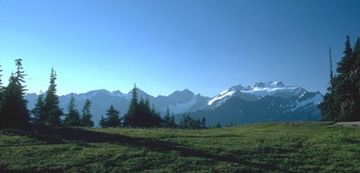Olympic Mountains facts for kids
Quick facts for kids Olympic Mountains |
|
|---|---|

|
|
| Highest point | |
| Peak | Mount Olympus |
| Elevation | 7,962 ft (2,427 m) |
| Geography | |
| Country | United States |
| State | Washington |
| Range coordinates | 47°50′N 123°50′W / 47.83°N 123.83°W |
| Parent range | Pacific Coast Ranges |
The Olympic Mountains are a large mountain range found on the Olympic Peninsula in western Washington, United States. These mountains are part of a bigger group called the Pacific Coast Ranges. They are known for their wild beauty and unique weather.
The eastern side of these mountains rises straight up from Puget Sound, which is at sea level. On the western side, a flat area about 20 to 35 kilometers (12 to 22 miles) wide separates the mountains from the Pacific Ocean. This western side is famous for being the wettest place in the 48 connected states of the U.S.
Most of the Olympic Mountains are protected inside the Olympic National Park. A very large part of this park, about 95%, is also part of the Olympic Wilderness. This means these areas are kept as wild as possible, with very few human changes.
Contents
Olympic Mountains: A Natural Wonder
The Olympic Mountains are a special place with tall peaks, deep valleys, and lush forests. They stand out because they are so close to the ocean. This closeness creates unique weather patterns and different types of natural environments.
The highest point in the range is Mount Olympus, which reaches 7,962 feet (2,427 meters) high. This peak is often covered in snow and glaciers, even in summer. The mountains are a popular spot for adventurers and nature lovers.
Where Are They Located?
The Olympic Mountains are located on the Olympic Peninsula, a large piece of land that sticks out into the Pacific Ocean. To the east, they face Puget Sound, a body of water connected to the Pacific. To the west, they are close to the open ocean.
This location means the mountains catch a lot of moisture from the Pacific. The air coming from the ocean hits the mountains, rises, cools, and drops its rain. This process creates the incredibly wet conditions on the western slopes.
Home to Olympic National Park
A huge part of the Olympic Mountains is protected within Olympic National Park. This park was created to save the amazing natural beauty and wildlife of the area. It includes towering peaks, ancient forests, and even parts of the coastline.
Inside the park, a large section is called the Olympic Wilderness. A wilderness area is a place where nature is allowed to be wild and untouched. There are no roads or buildings, and people can only explore it on foot or horseback. This helps protect the plants and animals that live there.
Amazing Weather and Ecosystems
The western slopes of the Olympic Mountains receive an incredible amount of rain. This makes them one of the wettest places in the United States. This heavy rainfall creates unique rainforests, like the Hoh Rainforest, which are full of giant trees and lush green plants.
In contrast, the eastern side of the mountains is much drier. This is because the mountains block the rain clouds, creating a "rain shadow" effect. This difference in rainfall means you can find very different types of plants and animals on opposite sides of the same mountain range.
For example, places like Hurricane Ridge on the drier side have open meadows and different kinds of trees. This variety of climates and environments makes the Olympic Mountains a fascinating place to study nature.
Plants and Animals
The Olympic Mountains are home to a wide variety of plants and animals. The wet rainforests support huge trees like Douglas-fir and Bigleaf Maple. These trees are often covered in mosses and ferns, making the forest look magical.
Many unique plants also grow here, including some that are found nowhere else in the world. For example, the Piper's bellflower is a special flower that only grows in the Olympic Mountains.
Animals like Roosevelt elk, black bear, and cougar live in these mountains. Many different types of birds also make their homes in the diverse forests and alpine areas. The park helps protect these creatures and their habitats.
Images for kids
-
Mount Anderson as seen from the East Fork of the Quinault River
-
The Hoh Rainforest supports many trees and epiphytes.
-
Hurricane Ridge supports dry subalpine and alpine conditions in the Olympics
See also
 In Spanish: Montañas Olímpicas para niños
In Spanish: Montañas Olímpicas para niños







